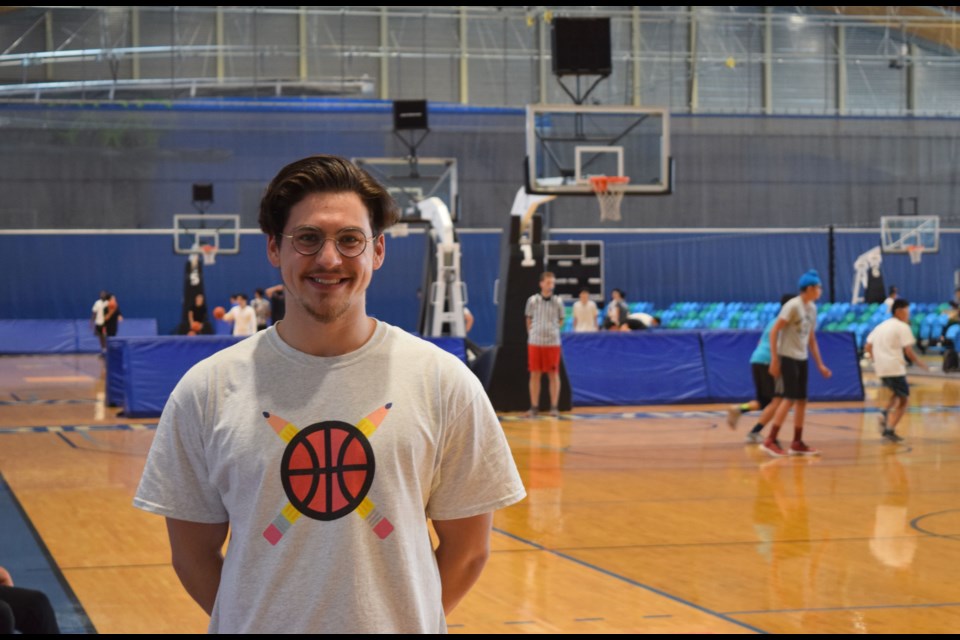Under the vaulted ceiling and twinkling lights of the Richmond Oval’s basketball courts, more than 60 high school students fought for points in a charity basketball tournament Tuesday.
It was called Hoop to Learn, organized by two university students to help high schoolers with learning challenges like dyslexia and ADHD successfully transition to post-secondary. Through the tournament and outreach, they’re hoping to raise funds for services to help those students.
“I’m dyslexic, and I felt that not enough light has been shined on this issue,” said Michael Jakac-Sinclair, who’s from Richmond and attends Carleton University.
He doesn’t want to go as far as to say the neurological condition he was diagnosed with in Grade 4 defined his entire education, since he was also a competitive swimmer. But it definitely had an impact.
He remembers being terrified of making a mistake while participating in Model United Nations in high school.
“You feel if you slip up on a word when you’re reading out loud … there’s a pack of wolves ready to pounce on you,” he said. “You have that anxiety built up.”
Dyslexia affects reading comprehension. Kids with the condition often struggle answering questions about a passage they’ve read but have no trouble when a passage is read aloud to them.
“There’s a gap between someone’s intellectual ability and what we would call their basic school performance … their ability to read, write and do arithmetic,” said Erin Kline, who works with dyslexic kids at the Fraser Academy, a private school in Vancouver.
That gap, though, doesn’t mean a student is any less intelligent than one of their peers.
“Your brain isn’t underdeveloped,” Jakac-Sinclair said. “Your brain is just working in a different way.”
Research supports how there may be a link between dyslexia and a propensity for creative thinking.
“Dyslexic students are so bright,” Kline said. “They are innovative thinkers and able to see the world in a slightly different way. They have the brains needed to solve the world’s current problems.”
Learning how to learn
Jakac-Sinclair feels fortunate that his family had the resources to send him to a private school to receive Orton-Gillingham tutoring. It’s one of several methods that help dyslexic kids find a different way to learn by exploring tactile, auditory and visual approaches.
He chose to partner with his old school for the inaugural basketball tournament. Going forward, though, he imagines he’ll partner with a variety of Lower Mainland organizations that benefit kids with learning challenges.
Jakac-Sinclair is now studying political science at Carleton. He thinks his transition was fairly smooth because he was well prepared. But he knows some of his peers weren’t so lucky.
That’s why he teamed up with Open Doors Education Initiative and Mahtab Singh Gill, a UBC student, to organize the basketball tournament for high school kids. Games were three-on-three with each team allowed one sub. In between the games, they listened to speakers like Mark Starkey of Vancouver Basketball share how they overcame their own challenges.
“A lot of well-known athletes have learning disabilities,” Singh Gill said. “But it’s not well-known because there’s a stigma factor.”
The registration fees collected from athletes were divided in half between the winner’s purse and the Fraser Academy’s new outreach centre.
The $1,500 donation will go towards after-school tutoring for students whose families may not be able to afford tutoring or full-time attendence at a specialized school. Even getting tested for the conditions can be costly, he says, and students need a diagnosis in order to access support services at most universities.
Going to university with a learning challenge
The transition from high school to post-secondary can be jarring for any student. For those with learning challenges, there’s an added layer of responsibility because they need to reach out to administrators to sort out paperwork for accommodations at every step of the way.
UBC, for example, offers accommodations like private exam rooms and voice-to-text software. But they require the student reach out and ask for them well in advance.
“We want to level the playing field so that the disability is not a barrier to them in demonstrating their academic competence,” said Ruth Warick, UBC’s senior accessibility advisor. “We want them to feel welcome in the university environment.”
But even if a student reaches out for these modifications, university classrooms can still be less than inviting for a dyslexic student,
“A lot of university, especially in the first two years, is far more lecture-bound. It necessitates a lot of reading from slides and tends to be a lot less hands-on and less visual,” Kline said. “It doesn’t necessarily lend itself well to being a positive learning environment for dyslexic students.”
Another part of the problem, Jakac-Sinclair thinks, is the stigma surrounding learning disabilities. While no student should feel ashamed to ask for the help they need, he thinks some do.
“We realized that the intersectional traits of this issue are deeper. It goes into mental health, cost of living, one’s social life,” he said.
He’s also organized town halls so kids can learn more about their challenge and meet peers facing similar issues. He thinks feeling accepted can go a long way toward success in school.
“We need to prepare high school students to advocate for their own learning.”



